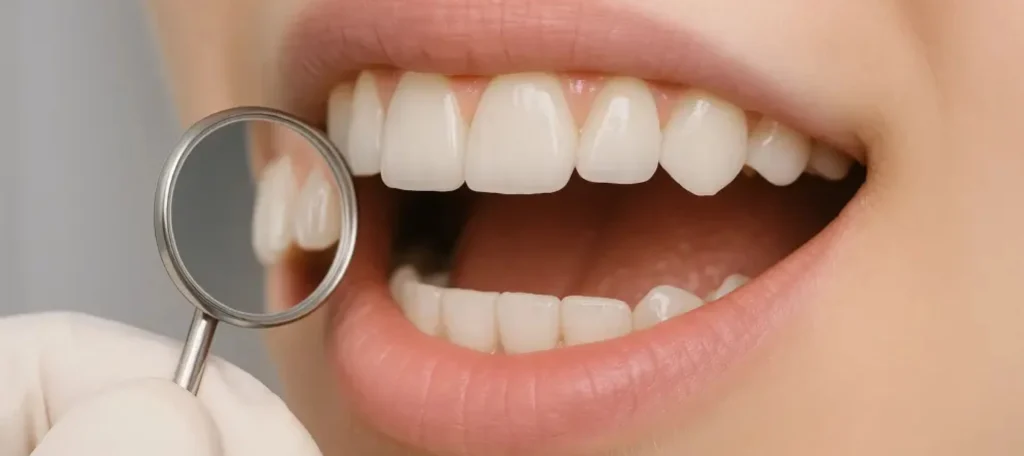When it comes to fixing a cavity or restoring a damaged tooth, most people think of a simple filling but there’s actually more to it than that. Today, dental clinics offer several types of dental filling based on your needs, budget, and oral health condition. Whether you’re getting a minor cavity treated or repairing a cracked tooth, knowing your options helps you make the best decision with your dentist.
Sometimes, a temporary dental filling is needed when the tooth can’t receive a permanent one right away. On top of that, it is quite common to experience a mild tooth sensitivity after the filling, particularly during the first few days after the procedure. But how much sensitivity is too much and when should you call your dentist?
In this article, we’ll break down the most common types of dental filling, explain when temporary ones are used, and what to expect afterward. Let’s help you walk into your dental appointment feeling informed, calm, and confident.
What Is Dental Filling?
A dental filling is a procedure designed to repair a tooth that has been affected by decay, wear or small fractures. Your dentist will remove the part of your tooth that is affected and fill the hole with material which will protect and give the shape of the tooth if bacteria have decomposed your tooth enamel and caused a cavity. Fillings not only stop the further decay of the tooth but also restore the function of chewing and the appearance of the tooth.
There are different types of dental filling materials, and the one your dentist chooses will depend on the location of the cavity, the size of the filling, your preferences, and your budget. Some fillings are meant to last for years, while others are short-term solutions.
Common Types of Dental Filling
First, let’s talk about the top types of dental fillings which are used mostly by dentists nowadays.
1. Composite resin fillings
Composite fillings consist of a resin that is of the same color as the tooth and that blends so well with your natural teeth that it becomes almost invisible. They are a preferred choice for front teeth or those areas that are visible to others. Even though they are not the most durable option, they are perfect for minor fillings and aesthetic changes.
2. Amalgam Fillings
Amalgam is a silver-colored material made from a mix of metals, including mercury, silver, and tin. It’s one of the most durable types of dental filling and has been used for over a century. Back teeth are where amalgam is generally used, as that is the location that experiences the most chewing pressure. The metal-like appearance of amalgam has resulted in its lesser popularity for the front teeth, which are visible.
3. Gold Fillings
Gold fillings are custom-made in a dental lab and then cemented into place. They are really strong and can even be used for 20 years. Even though they are expensive and more visible, they are usually the ones that are selected among the various types of dental fillings for patients who desire long-lasting solutions.
4. Ceramic Fillings
Made from porcelain, ceramic fillings are resistant to staining and are very strong. As one of the common types of dental fillings, they’re typically used for larger cavities and often look just like natural enamel. However, they can be more brittle than composite or gold.
5. Glass Ionomer Fillings
These are usually used for children or for fillings below the gumline. They release fluoride gradually, which gives the tooth a chance to repair itself from damage. But, at the same time, they are not as strong as other types of dental fillings.
Each material has its advantages and disadvantages, and the dentist is the one who is to decide with you the best solution for your dental needs and the place of the tooth to be filled.
Step-by-Step: What Really Happens During a Dental Filling?
If you have never had a cavity treated you might be wondering about the process and need some information about how the treatment is done to any types of dental fillings. The dental filling procedure is usually quick and straightforward, taking about 30 to 60 minutes depending on the size and number of cavities.
First, your dentist will numb the area around the affected tooth to make sure you’re comfortable.
After that, the dentist will remove the carious part of the tooth with a dental drill or laser. When the space is clean, your dentist will shape it and start filling it with the selected material.
Depending on the types of dental filling used, like composite, amalgam, or ceramic. The dentist might use a curing light to harden the material layer by layer.
Once the filling has been done, they will give it the shape of your bite and polish it. Your dentist will make sure however it fits well and feels comfortable and smooth while you close your mouth before you leave.
Temporary Dental Filling: When Is It Used?
Sometimes your dentist won’t place a permanent filling right away. A temporary dental filling might be needed if:
- There’s too much decay and the tooth needs more time before final treatment
- A root canal has to be done and the dentist wants to seal the area until the next visit
- A dental emergency is definitely a reason for getting a quick fix until a full treatment can be done
Temporary fillings unlike other types of dental fillings are made from soft materials like zinc oxide or eugenol-based compounds. They’re not meant to last forever but can protect the tooth short-term.
How Long Does a Temporary Dental Filling Last?
Many patients ask, how long does a temporary dental filling last? Does it differ from other types of dental fillings in both longevity and purpose?
The answer depends on the material used and where the filling is located, but in general, it lasts between a few days to several weeks. Some can stay intact for a few months if needed, but they will eventually wear out, break, or fall off.
That’s why it’s important to follow your dentist’s instructions. A temporary dental filling is not as strong as a permanent one and could let bacteria back into the tooth if left in place too long.
Tooth Sensitivity After Filling: What’s Normal?
It’s very common to feel some tooth sensitivity after filling, especially to temperature changes, pressure, or sweet foods. This sensitivity can last a few days to a couple of weeks, depending on the size of the filling and how deep the cavity was and even the types of dental fillings used.
If the filling was near the tooth’s nerve or if the bite isn’t adjusted correctly, the sensitivity may linger. But if the pain is severe, lasts more than two weeks, it’s important to go back to your dentist.
Tips to manage tooth sensitivity after filling:
- Use toothpaste designed for sensitive teeth
- Avoid extreme temperatures in food and drinks
- Chew on the opposite side for a few days
- Avoid very hard or sticky foods

What to Expect After Getting a Filling
After your appointment, your mouth might still be numb for a couple of hours. It’s a good idea not to eat right away, otherwise, you might end up biting your cheek or tongue without realizing it.
You might feel pressure or mild pain when biting, especially if the filling is slightly too high. Let your dentist know if this happens, they can adjust it easily.
Most people find their new filling comfortable within a few days. Regardless of the types of dental fillings you receive, you should just keep doing your regular brushing and flossing and at the same time, stay away from chewing ice or other hard things.
Dentist’s Advice: Caring for Your Fillings Long-Term
The best advice from your dentist? Prevention is definitely the most important. Even the most durable types of dental fillings can’t go on forever if you don’t maintain good oral hygiene. Follow these steps to protect your fillings and maintain your oral health:
- Brush twice a day with fluoride toothpaste
- Floss daily to remove plaque between teeth
- Avoid sugary snacks and drinks that feed bacteria
- Visit your dentist every 6 months for checkups and cleanings
If you grind your teeth at night, your dentist might recommend a mouthguard to protect your fillings and other restorations. And if you ever feel a sharp edge, a loose filling, or have a sudden pain, do not hesitate to call your clinic immediately.
Conclusion: Choosing the Right Types of Dental Filling for You
There are several types of dental filling available, from composite resin to gold, each with their own benefits. Whether you’re receiving a long-term solution or just a temporary dental filling, understanding your options helps you make an informed choice with your dentist.
You might still be wondering, how long does a temporary dental filling last? Or if it’s normal to feel tooth sensitivity after filling. These are valid concerns and the good news is, they’re common and manageable with the right care and guidance from your dental provider.
Choosing the right material from the different types of dental fillings, caring for your fillings, and keeping regular dental appointments will keep your smile strong and healthy. Your dentist is your best partner in maintaining oral health, so don’t hesitate to ask questions during your next visit. With the right information and a bit of care, all types of dental fillings can last for many years to come.
Source:
https://www.healthline.com/health/dental-and-oral-health/composite-fillings?utm_source=chatgpt.com




